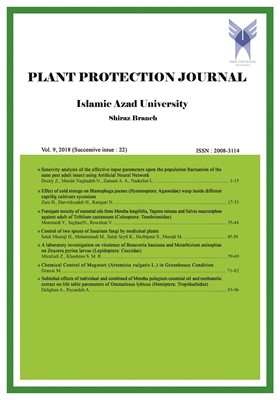Effect of cold storage on Blastophaga psenes (Hymenoptera: Agaonidae) wasp inside different caprifig cultivars syconium
Subject Areas : Plant ProtectionHamid Zare 1 , Hadi Darvishzadeh 2 , Nowzar Rastegari 3
1 - Fig Research Station, Fars Agricultural and Natural Resources Research and Training Center, AREEO, Estahban, Iran
2 - Estahban Jihad -Agriculture Department, Estahban, Iran
3 - Plant Protection Department, Fars Agricultural and Natural Resources Research and Education Center
Keywords:
Abstract :
For fruit set in edible figs, Blastophaga psenes wasp inside caprifig syconium has important role. To synchronize of wasp exit from caprifig syconium and flower reception inside fig syconium, effect of cold storage was evaluated on wasp. In order to determine the effect of cold storage with 4 oC on wasps inside syconia of four caprifig cultivars of Gohari, Shanehi, Kouhi and Poozdombali, this experiment was carried out in a randomized complete design at laboratory conditions in Estahban figs research station in 2017. The results showed that caprifigs syconia of Gohari, Kouhi and Poozdombali cultivars had the highest number of living female B. psenes wasps after two days storage in cold, and the number of survived wasps gradually decreased until the 10th day of cold storage. Kouhi and Gohari caprifigs syconia had the largest and lowest living male B. psenes wasps from the beginning to 10th storage day, respectively and their number decreased gradually with an increase in storage time. The ability to withstand in cold storage condition for female B. psenes wasps inside syconia of Gohari, Shanehi, Kouhi and Poozdombali cultivars was extended until 18, 14, 22 and 32 days of cold storage, respectively. Caprifig syconium of Gohari cultivar was more effective in figs caprification with the highest of living female wasp and the highest ratio of wasp number to syconium weight. Caprifig syconium of Poozdombali cultivar showed a good storage tolerance without any adverse effect of cold storage on syconium and with the lowest mortality of pollinator wasps.
_||_


